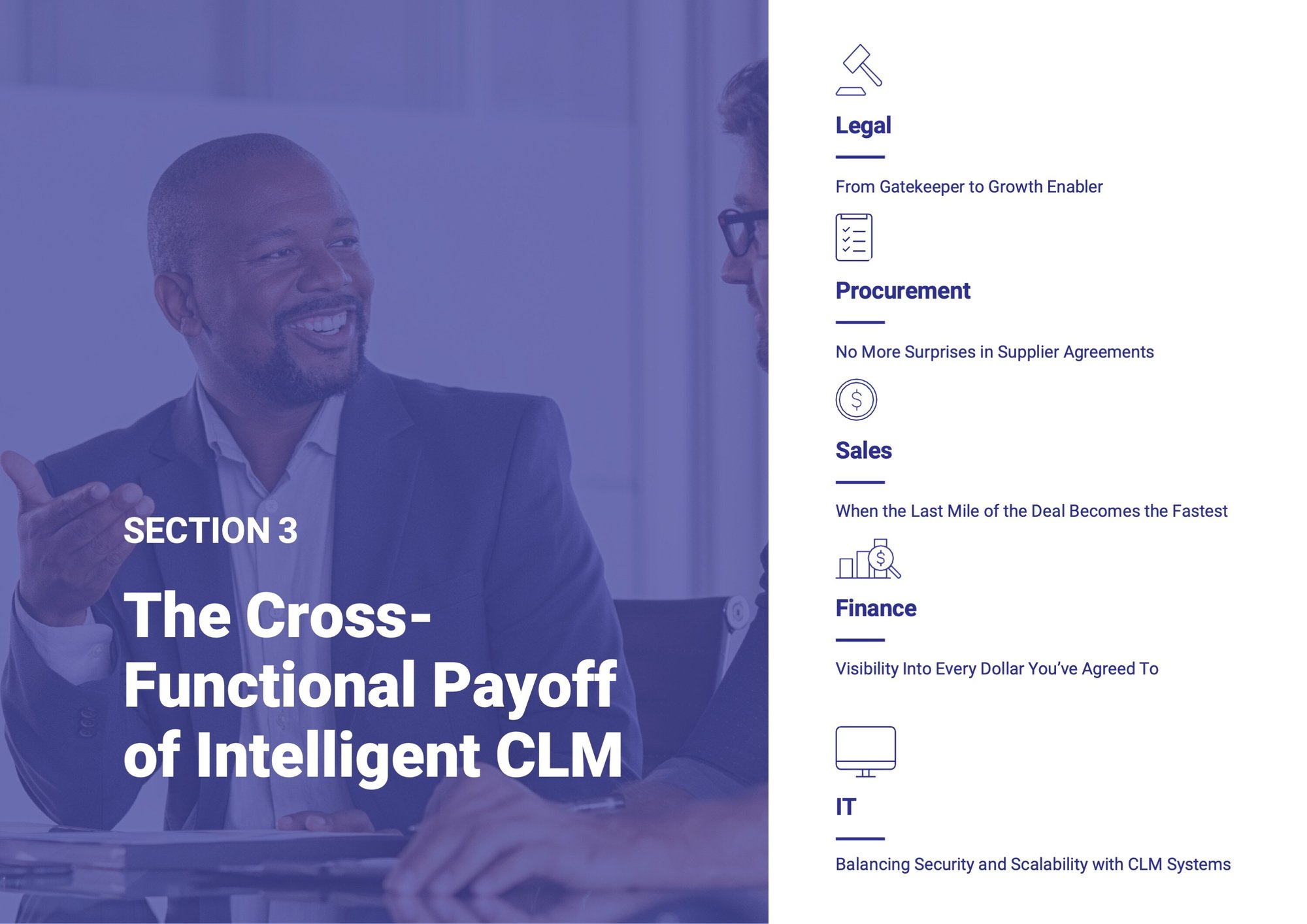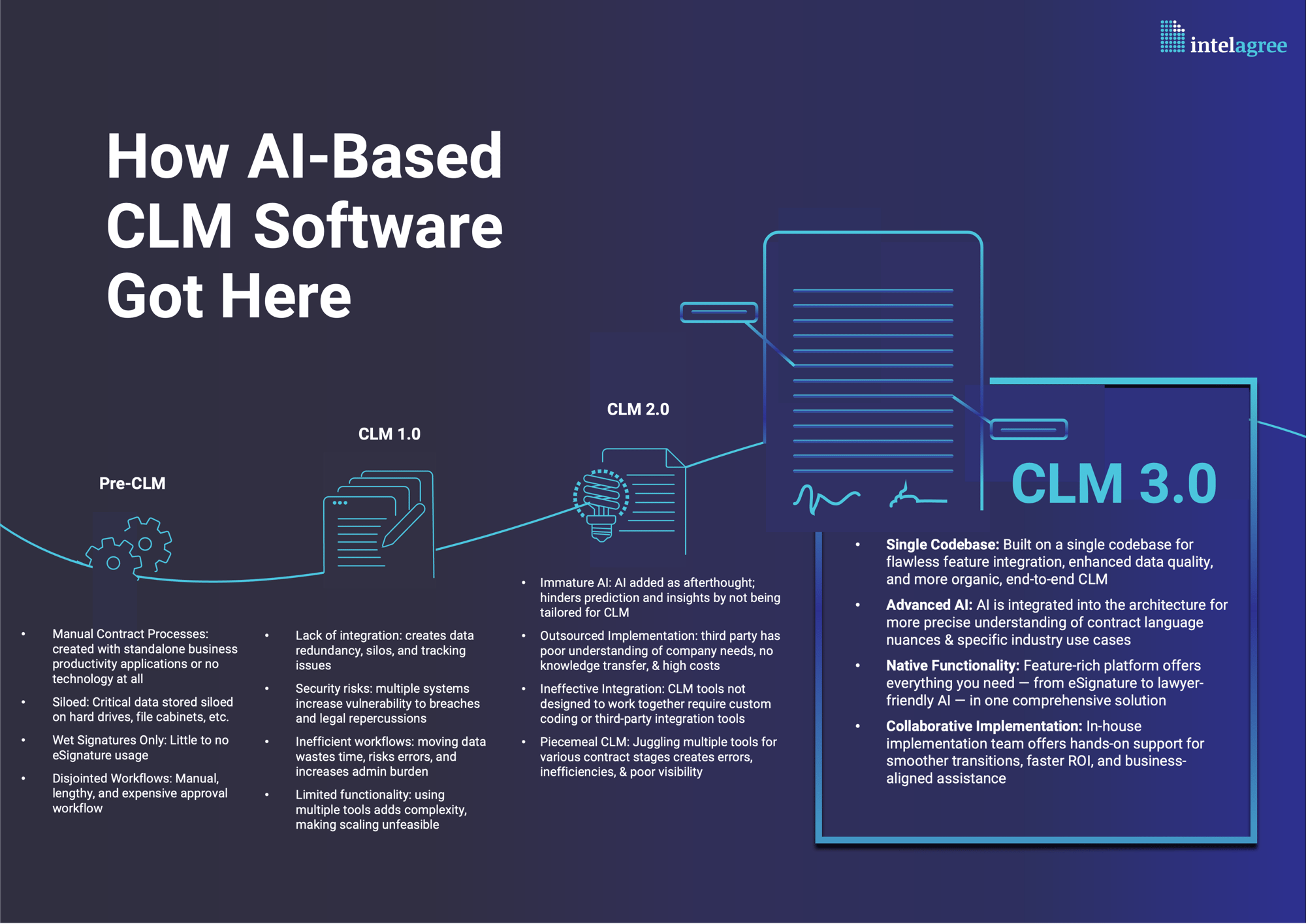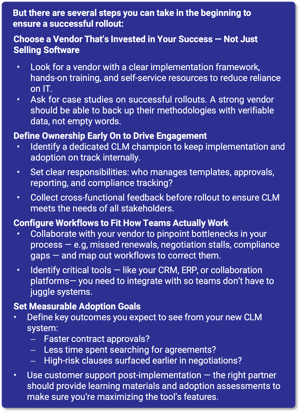
Turn Contracts Into Corporate Assets:
How to Build Your Business Case for AI-Based CLM Software
Read the full playbook below, or download the PDF to take it with you.

TABLE OF CONTENTS
Read More
Free live ROI Calculator Included.
Read MoreINTRODUCTION
Proving the need for better contract management isn’t as simple as saying, “This process is broken.” Leadership wants data that shows where inefficiencies are costing the business. They want to see the numbers, the measurable impact across every department, and clear evidence that CLM software drives better outcomes than the status quo. What they don’t want is another system that promises efficiency but fails to prove its worth once implemented.
This playbook helps you make that case. It breaks down how contracts impact legal, sales, finance, and procurement and shows you how to connect CLM to the outcomes that matter to each team. Whether you’re trying to reduce risk, prevent revenue loss, or improve deal velocity, you’ll find the insights, data points, and strategies you need to build internal buy-in.
INSIDE YOU’LL FIND:
- A breakdown of hidden contract risks, costs, and inefficiencies — and how to fix them
- Department-specific insights on how CLM creates measurable impact
- A framework for measuring ROI and handling objections from decision-makers
- A vendor scorecard and checklist to help you choose the right solution
Most businesses know they can manage contracts better. The question is if they can afford to keep managing them the way they do now.
Let’s get started.
Section 1
The High Cost of Doing Nothing: Why Waiting to Fix Contract Management Is a Risk You Can’t Afford
Some contract risks are obvious. Others aren't — until it’s too late.
A supplier fails to meet obligations, and no one catches it until penalties pile up. A renewal auto-executes at outdated pricing, quietly inflating costs. A deal gets stuck in negotiations, and the customer walks.
Contracts touch every dollar in and out of the business. Yet, they’re often scattered across inboxes, buried in shared drives, or managed poorly through outdated systems, and the impact is staggering:

Contract mismanagement isn’t one problem — it’s a system of invisible failures that add up. Luckily, it’s something AI-powered CLM software is designed to fix. In the next section, we’ll talk about how these tools turn contracts into real
assets: accessible, trackable, and built for business impact.
SECTION 2
Why AI-Based CLM Software is a
Business Advantage
Sales teams want faster deal closures. Finance focuses on cost control. Legal prioritizes risk reduction. Every department has different priorities, but they all share the same dependency: contracts.
Contract Clarity & Consistency Benefits Everyone
When contracts are accessible, intelligent, and connected, every department works better — not just on their own, but together. AI-powered CLM makes that possible by turning contracts into a shared source of speed, insight, and alignment:
Contracts sit at the intersection of every major business function, influencing costs, revenue, and supplier terms. AI-powered CLM software makes this information actionable, helping leaders optimize negotiations, control costs, and mitigate risk.
Next, we’ll explore how individual departments — from legal to finance to IT — can use AI-powered CLM software to drive smarter business outcomes.

Legal:
From Gatekeeper to Growth Enabler
Legal teams face immense pressure from every direction. Stakeholders want contracts turned around faster. Regulators expect airtight compliance. The C-suite needs legal to manage risk without slowing deals down.
But here's the problem:
- Contract review eats up hours. Routine redlines, manual risk assessments, and tracking down key contract terms take time away from higher-value legal work.
- Compliance is a moving target. Regulations change, and tracking obligations across hundreds (or thousands) of agreements is nearly impossible without the right tools.
- Stakeholders bypass legal altogether. Frustrated with slow turnaround times, teams may use outdated templates or sign agreements without proper review — exposing the business to unnecessary risk.
- Legal is blamed when things go wrong. Missed renewal deadlines, unfavorable terms, or a contract dispute? The spotlight turns to legal, even when the root issue is poor contract visibility.

AI-powered CLM software, however, removes the roadblocks that slow legal down. Machine learning models analyze contracts in seconds, flagging risky clauses, deviations from standard terms, and missing obligations — so legal doesn’t have to hunt for them. Automated approval workflows route contracts to the right stakeholders instantly, eliminating the manual back-and-forth that drags out negotiations. Intelligent CLM software ensures every contract is searchable, every obligation is tracked, and every action — edits, approvals, renewals — is logged automatically.
The result? Contract management stops being a source of friction, and legal teams regain the time, visibility, and control they need to protect the business without slowing it down.
Procurement:
No More Surprises in Supplier Agreements
Pricing, SLAs, rebate thresholds, renewal timelines — every supplier decision comes down to numbers. Procurement teams live by these figures, but the reality is that contract data isn’t always where it needs to be. It’s scattered across systems, buried in PDFs, or stored in spreadsheets that only a handful of people maintain. Teams operate on outdated price sheets, suppliers reference different terms, and by the time discrepancies are caught, the business has already lost leverage — or money.
Before a contract renews or a supplier agreement is signed, procurement teams need to know:
- Are we unknowingly overpaying because of outdated terms or missed renegotiations?
- Do we have unclaimed rebates or discounts buried in supplier agreements?
- How many of our vendor contracts renew soon, and are we prepared to renegotiate?
- Which suppliers are consistently failing to meet SLAs, and where is that costing us?

AI-powered CLM brings contract intelligence to the forefront, making supplier agreements easier to manage and optimize. AI scans contracts to highlight price variations, automatic renewals, and missed cost-saving opportunities — giving procurement teams the leverage to act before terms are locked in. Automated alerts keep approvals moving forward, ensuring negotiations happen on time.
With AI ensuring every agreement is optimized and enforceable, procurement teams are better equipped to reduce costs, strengthen supplier relationships, and enhance business outcomes.
Sales:
When the Last Mile of the Deal Becomes the Fastest
Reps know their contract pipeline inside and out. What they don’t always know is how contracts impact those deals once they’re in motion. A customer renewal is coming up — was there an opportunity to upsell? A price adjustment clause exists — did anyone catch it before sending the quote? A deal stalls in legal — who’s responsible for moving it forward? When these answers aren’t clear, revenue slips through the cracks.
Here’s how contract delays hurt sales the most:
- Closing slows down. A deal is won, but contract approvals take too long, delaying revenue recognition.
- Reps lose control. Every redline means another round of approvals, pulling legal into simple, repeatable agreements.
- Renewals go untracked. A customer churns because no one flagged their contract expiration in time.
- Time is wasted. Instead of selling, reps are stuck chasing signatures, finding the right templates, or waiting for legal feedback.

With AI-powered CLM, sales teams don’t have to rely on legal for routine contracts. They generate agreements instantly using pre-approved templates, so standard deals move forward without delays.
AI makes it easier to find upsell opportunities, pricing flexibility, and renewal terms before it’s too late.
Generative AI allows reps to ask, “What’s the termination clause in this agreement?” or “When does this customer’s discount expire?” and get an immediate answer — no searching, no legal bottlenecks.
Finance:
Visibility Into Every Dollar You’ve Agreed To
Finance teams thrive on predictability. They track every dollar in and out of the business, forecast revenue, and ensure compliance with financial regulations. But unpredictability doesn’t just come from market shifts or economic downturns — it comes from within the contracts that govern every financial obligation.
This is how contract risk becomes a financial problem:
- Creates forecasting gaps. Without visibility into upcoming renewals, variable pricing structures, or contract expirations, revenue projections become guesswork.
- Cash flow disruptions. Payment terms and escalation clauses exist in contracts, but without tracking, discounts are missed and late fees go unbilled.
- Profit margin erosion. Suppliers don’t always apply negotiated discounts, and customers don’t always pay what they owe. When contracts aren’t enforced, finance bears the cost.

AI-powered CLM brings financial predictability back into contracts by making every term, deadline, and obligation visible and actionable. Instead of manually tracking payment schedules, escalations, or renewal dates, finance teams receive automated alerts before revenue is lost or costs increase.
AI scans agreements to flag discrepancies — missed pricing adjustments, billing errors, or unclaimed cost savings — so finance teams can act before problems hit the balance sheet.
IT:
Balancing Security and Scalability with CLM Systems
When technology works, no one notices. When it doesn’t, IT takes the heat. That’s why every new platform must meet a high bar: will it integrate smoothly, protect sensitive data, and scale without creating more work? Contract management is no different — if contracts exist in silos, IT carries the burden of fixing broken workflows, troubleshooting integrations, and managing access issues.
Some of the challenges that IT teams face include:
- Fragmented Systems. Contracts stored in standalone tools create data gaps between CRM, ERP, and procurement platforms.
- Security Risks. Uncontrolled access and weak audit trails make compliance difficult.
- Scalability Struggles. Outdated systems can’t support growing contract volumes or evolving business needs.
- Unnecessary Maintenance. Workarounds, manual data pulls, and permission issues add to IT’s workload.

AI-powered CLM software is designed to integrate with the systems IT teams already trust. Instead of forcing teams to manage contracts in yet another disconnected system, end-to-end CLM software connects key contract data with Salesforce, Workday, and other enterprise applications, ensuring workflows stay intact.
Security features — like role-based access, encryption, and audit logs — keep sensitive contract data protected without requiring extra oversight.
As contract volumes grow, AI-driven workflows scale with the business, reducing IT’s long-term maintenance burden.
What the Future of Contracting Looks Like — and Why AI is Inevitable
Many companies think they’ve modernized contract management because they’ve digitized agreements. But digital storage isn’t contract intelligence — it’s just a more organized version of the past. AI-powered CLM is transforming contracts into live assets that shape financial strategy, not just document it.
How AI Is Transforming Contract Management:
- Obligation Tracking – Extracts payment terms, renewal dates, and compliance obligations, then triggers automated alerts to prevent missed deadlines.
- Risk Scoring & Compliance Monitoring – Scans contracts for high-risk clauses and deviations from company standards, and helps with assigning risk scores so teams can understand their liabilities.
- Contract Data Extraction & Organization – Reads contracts, identifies key terms, and structures them into a searchable format, so users can find what they need in seconds.
- Generative AI for Instant Answers – AI-powered chatbots allow teams to get contract-specific answers to questions like, “What are the termination rights for this Vendor?”
- Advanced Contract Analysis – AI compares new agreements against historical contracts, highlighting differences in pricing, liability, and other terms to improve negotiations.
- Negotiation Intelligence – Provides fallback clauses and standard positions during negotiation, so teams can reply faster, stay consistent, and close stronger agreements without starting over.



Results
If your answer was “Not a critical need,” then you:
Likely have a CLM system in place, possibly even one that claims to use AI — but not all AI-powered CLMs are created equal. Some platforms are overly complex to configure, making automation more of a burden than a benefit. Others aren’t truly end-to-end, leaving teams stuck with manual workarounds for key contract stages. Even if your current system seems to work, it’s worth assessing whether it’s driving efficiency — or just creating new bottlenecks under a different name. It’s also worth examining how easily the CLM platform integrates with systems your teams already use — like Salesforce, Workday, or your legal tech stack — since poor integration can quietly undermine adoption and limit cross-functional impact.
If your answer was “Needs deeper assessment with your teams,” then you:
Might have a system, but without automation, contract intelligence, or cross-functional visibility, it’s not fixing the core issues. Or maybe you’re getting by without a CLM, and the friction just hasn’t caught up — yet. But as volume grows, so will delays, risks, and compliance gaps. That’s why it’s worth assessing how well your current approach supports the way your teams actually work. Does it provide AI-powered visibility into obligations and risks, or leave legal and procurement chasing down answers? Does it integrate not just with your CRM or ERP, but with the broader legal tech stack your teams rely on? If the system can’t adapt to how your teams operate — like routing requests from Aqua or auto-generating contracts during onboarding — it’s likely creating more work than it’s solving.
If your answer was “Yes, you need it,” then you:
Are already feeling the strain of slow approvals, missed obligations, and scattered contract data — and it’s costing your business. At this stage, the question isn’t whether you need CLM, but which vendor is the right fit. Not all solutions offer true AI-powered contract intelligence, seamless integrations, or automation that actually reduces workload. The next step is narrowing your options by evaluating platforms on usability, configurability, and AI capabilities to ensure your CLM investment drives real business impact.
Want to share or revisit later?Download the flowchart to assess your need for AI-powered CLM.
The Formula for Proving ROI With AI CLM
Quantify the impact of AI-powered contract management on your business.*
Common Objections You’ll Hear — and How to Answer Them
A process that “works” isn’t the same as one that’s optimized. The biggest threat to contract management isn’t just bad contracts — it’s good contracts trapped in a bad system:

- “It’s Too Expensive”
- “Our Manual Process Works Fine”
- “It’s Too Difficult to Integrate”
- “We Already Have a CLM System”
- “It’s Not a Priority Right Now”
Objection 1: "It's Too Expensive"
Counterargument: Hidden costs in contracts accumulate whether a company tracks them or not. Companies that think they’re “saving” by not investing are usually the ones unknowingly overspending due to contract blind spots.
Key points:
- Budget overruns start in contracts. How many vendor agreements have unclear escalation clauses or pass-through costs that weren’t caught? CLM ensures spending aligns with what was negotiated.
- M&A and financing rely on contract intelligence. Investors, acquirers, and auditors scrutinize contract risk exposure. A poor contract management process can lead to valuation disputes or hidden liabilities.
- Budgeting for CLM is a fixed expense; failing to track contract risks is an unpredictable liability. The cost of inaction only becomes clear after money has already been lost.
Objection 2: “Our Manual Process Works Fine”
Counterargument: The problem with manual processes isn’t just inefficiency — it’s blind spots. Without AI-driven oversight, companies don’t know what they don’t know.
Key points:
- Non-standard terms often slip through unnoticed. Without AI, contract deviations can lead to unapproved risks, misaligned SLAs, or customer discounting errors.
- Contract risk isn’t always visible until litigation. Many disputes happen years later, after leadership has changed, teams have turned over, and no one remembers what was originally agreed upon.
- Regulatory complexity is outpacing manual compliance. New reporting requirements, ESG clauses, and privacy laws make contract oversight a legal liability. AI ensures compliance doesn’t become a lawsuit waiting to happen.
Objection 3 : “It’s Too Difficult to Integrate"
Counterargument: The assumption that CLM is a standalone system is outdated. AI-powered CLM is a connective layer, ensuring contract data flows where it’s needed.
Key points:
- It’s not a new system — it’s a missing piece. CLM connects to CRM, ERP, and eSignature tools that you use daily — like Workday, Salesforce, Microsoft Office, and more — to make existing workflows more efficient.
- AI-driven contract insights improve data governance. CLM eliminates shadow agreements and ensures there’s a single, structured, auditable contract record — a key requirement for modern cybersecurity and compliance frameworks.
- No-code workflow automation reduces IT dependence. Unlike legacy contract tools, AI-powered CLM doesn’t require IT to maintain rule-based workflows or custom scripts.
Objection 4: “We Already Have a CLM System”
Counterargument: Many CLM systems add structure, but not strategy. If teams still struggle to measure contract performance, align terms across departments, or adapt agreements to shifting business needs, the system is just maintaining the status quo.
Key points:
- If a system requires workarounds, it’s not solving the right problems. AI provides real-time contract intelligence without requiring teams to create their own tracking systems.
- Negotiating from a position of strength requires knowing contract history. AI helps teams compare past agreements, spot unfavorable patterns, and bring leverage to the table.
- Legal, finance, and procurement should never have different versions of the truth. AI ensures contract visibility is aligned across all departments to prevent miscommunication and financial risk.
- CLM should enhance — not compete with — your existing legal tech stack. Whether it’s IP portfolio systems or e-discovery tools, modern CLM software should make it easy to pass data, assign tasks, or trigger workflows across tools.
Objection 5: “It’s Not a Priority Right Now”
Counterargument: A company’s ability to pivot, innovate, and expand is only as strong as its contracts allow. If agreements are rigid, outdated, or misaligned with business strategy, they aren’t just an administrative issue — they’re a structural constraint.
Key points:
- Your CLM process might work today, but will it work at 2x, 5x, or 10x the volume? AI ensures contract oversight scales with the business, preventing bottlenecks.
- Not prioritizing CLM is an implicit decision to accept hidden liabilities. AI turns contracts into measurable business assets, ensuring they aren’t a blind spot in financial planning.
- What’s not a priority today becomes a crisis tomorrow. CLM ensures that contract risks don’t escalate into lost deals, supplier disputes, or regulatory fines.
A Practical Checklist for Vetting CLM Software Vendors




Want to take the checklist with you? Download it here and work through it with your team.
How to Avoid CLM ‘Shelfware’ and Drive Better Adoption
Implementation is as much a mindset shift as it is a technological shift. CLM adoption often fails for one of three reasons:
1. Implementation was rushed (or handled by the wrong people). If teams aren’t engaged early, don’t understand the system, or workflows aren’t customized, people won’t use it.
2. There’s no clear ownership or accountability. CLM is cross-functional, but when no one takes charge of adoption, departments fall back into old habits.
3. The system is underleveraged. A CLM platform’s value is in its automation, intelligence, and integration, not just storage capacity. If teams don’t know how to use these features, they won’t see the real ROI.


Wrapping Up
No one invests in CLM software just to swap one set of frustrations for another. The goal is to eliminate the bottlenecks, risks, and inefficiencies that make contract management a constant uphill battle. But getting to that outcome depends on choosing the right system — and the right vendor.
Red flags to watch for when evaluating CLM vendors:
- Vague or overly controlled demos – AI should be easy to test. If a vendor won’t provide hands-on access, question why.
- Unrealistic AI promises – Features that don’t exist yet or sound too good to be true often are. A solution should work now, not be a future update.
- Lack of real-world proof – Strong AI solutions come with case studies, measurable results, and customer success stories. If there’s no proof, there’s a reason.
- Lack of transparency – A vendor should clearly explain how their AI works, what data it uses, and how security is handled.
- Being quick to change pricing – Frequent pricing adjustments, unclear cost structures, or unexpected fees signal instability. A vendor should be clear about costs from the start.
The right CLM system should feel less like another tool to maintain and more like a competitive advantage — one that keeps teams ahead of risks and roadblocks instead of reacting to them. IntelAgree was built to give companies full control over their contracts, helping them close stronger deals, enforce better terms, and eliminate costly mistakes before they happen.








